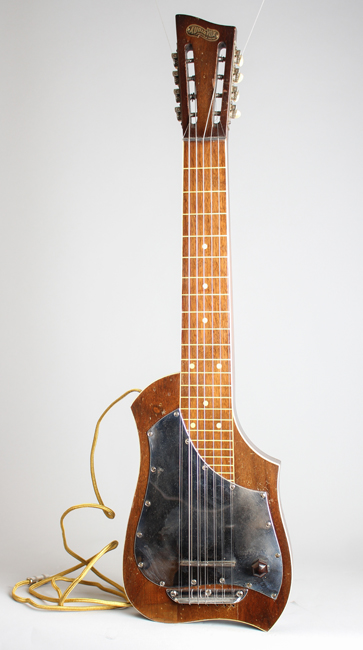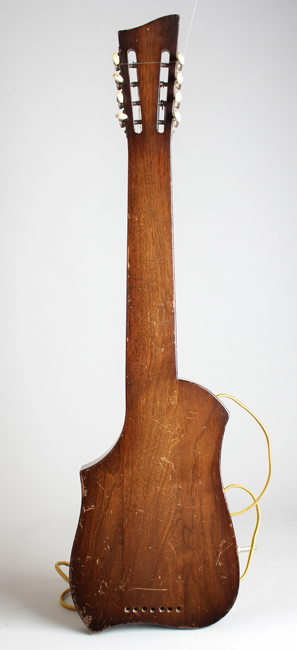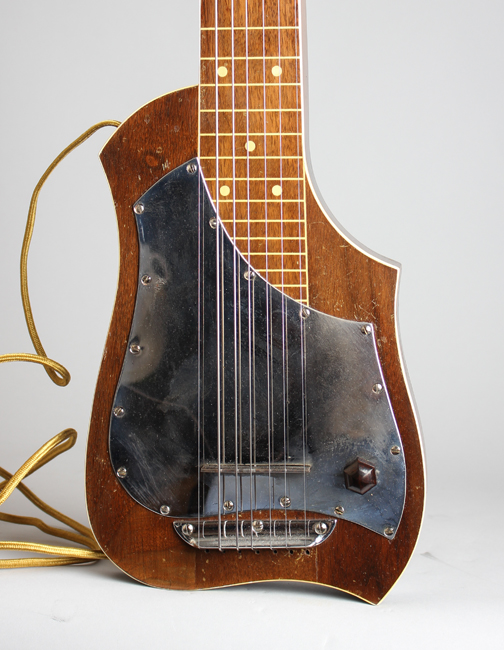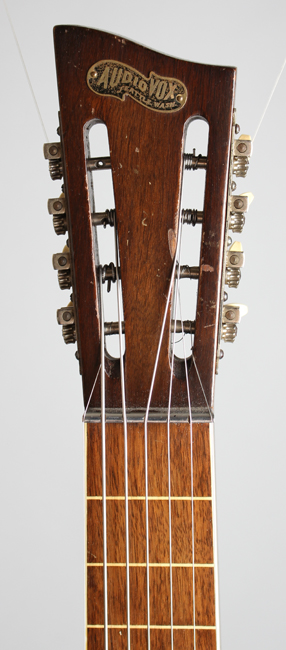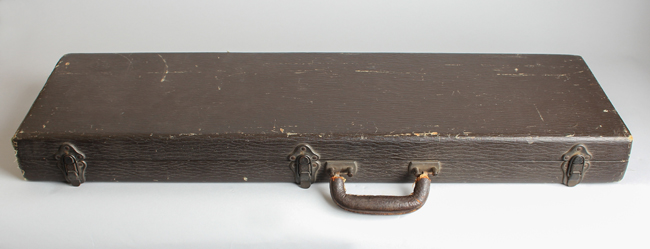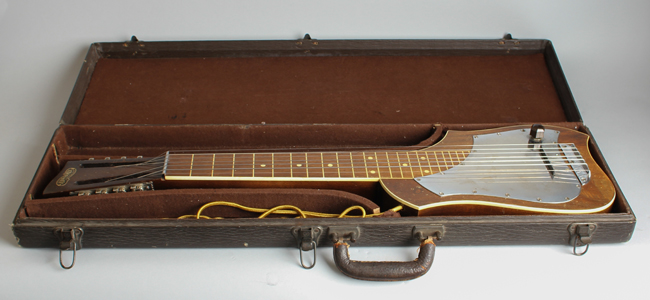Audiovox 7-String Lap Steel Electric Guitar (1930's)
This item has been sold.
Item # 4743
Prices subject to change without notice.
Audiovox 7-String Model Lap Steel Electric Guitar (1930's), made in Seattle, WA, natural mahogany finish, walnut body and neck, original black hard shell case.
Perhaps the great "lost" story in the history of electric guitars, the Audiovox brand has only recently emerged from obscurity as the legacy of one of the first pioneers of musical electrification, Paul Tutmarc. While not as well-remembered as the contemporary early Rickenbacher Electro, Vivi-Tone or National/Dobro electrics Tutmarc's AudioVox instruments were in production at the same time, and in some ways are more forward-looking than any. It has been recently proven that Tutmarc was the first to create a guitar-style electric bass, many years before Leo Fender. This early Audiovox steel was handmade by Tutmarc's tiny firm in the mid-1930's and is a wonderful piece of electric guitar history.
Tutmarc was a Seattle player and teacher of the Hawaiian guitar who became fascinated by the concept of amplifying his instrument around 1930. With the help of another Washington resident and electronics expert, Art Stimpson, Tutmarc designed a working magnetic guitar pickup based on contemporary telephone technology. With the help of local radio expert Bob Wisner an accompanying amplifier was also created. Tutmarc soon began hand-building solidbody steel guitars using his pickup, but Stimpson favored selling the idea to an established company. Soon enough, without consulting his partner Stimpson took the design to Dobro in Los Angeles, where it was patented as part of a proprietary guitar and became the basis for the first National and Dobro electric instruments. Tutmarc was no doubt highly displeased by this development, but continued to refine and market his own electric instruments, albeit only on a small local scale.
This is an early production Audiovox 7-string Steel guitar, built with the amazingly advanced-looking fluid sculptured body that superseded the octagonal shape first used in 1932-3. The earliest electric bass used this same body style. According to Tutmarc's son Bud the woodworking and finishing on these first production steels was done by another Seattle resident, Emerald Baumsgard. Tutmarc himself fitted the electronics. The body is mahogany, very nicely sculpted and finished, with a celluloid bound neck and edges and dot fret markers. The bridge and nut are metal, as is the coverplate on the face. The bulky pickup coil is concealed underneath this, with only the blade polepiece visible. A single volume pot with an octagonal radio-style knob is mounted on the treble side. Although the instrument is built for 7 strings, there are 8 pegs as a set of standard '20's style Waverly mandolin tuners was used. This is a very fine sounding steel, and an extremely rare and important instrument in the early development of the electric guitar.
Overall length is 31 in. (78.7 cm.), 8 11/16 in. (22.1 cm.) wide at lower bout, and 1 5/8 in. (4.1 cm.) in depth, measured at side of rim. Scale length is 22 1/2 in. (572 mm.). Width of nut is 2 3/16 in. (56 mm.). All original with some general wear, except the pickup was just perfectly rewound by the amazing Tom Brantley. The hard wired cord is more recent as well. A very good sounding cool, and early steel with the original HSC. Excellent Condition.
Perhaps the great "lost" story in the history of electric guitars, the Audiovox brand has only recently emerged from obscurity as the legacy of one of the first pioneers of musical electrification, Paul Tutmarc. While not as well-remembered as the contemporary early Rickenbacher Electro, Vivi-Tone or National/Dobro electrics Tutmarc's AudioVox instruments were in production at the same time, and in some ways are more forward-looking than any. It has been recently proven that Tutmarc was the first to create a guitar-style electric bass, many years before Leo Fender. This early Audiovox steel was handmade by Tutmarc's tiny firm in the mid-1930's and is a wonderful piece of electric guitar history.
Tutmarc was a Seattle player and teacher of the Hawaiian guitar who became fascinated by the concept of amplifying his instrument around 1930. With the help of another Washington resident and electronics expert, Art Stimpson, Tutmarc designed a working magnetic guitar pickup based on contemporary telephone technology. With the help of local radio expert Bob Wisner an accompanying amplifier was also created. Tutmarc soon began hand-building solidbody steel guitars using his pickup, but Stimpson favored selling the idea to an established company. Soon enough, without consulting his partner Stimpson took the design to Dobro in Los Angeles, where it was patented as part of a proprietary guitar and became the basis for the first National and Dobro electric instruments. Tutmarc was no doubt highly displeased by this development, but continued to refine and market his own electric instruments, albeit only on a small local scale.
This is an early production Audiovox 7-string Steel guitar, built with the amazingly advanced-looking fluid sculptured body that superseded the octagonal shape first used in 1932-3. The earliest electric bass used this same body style. According to Tutmarc's son Bud the woodworking and finishing on these first production steels was done by another Seattle resident, Emerald Baumsgard. Tutmarc himself fitted the electronics. The body is mahogany, very nicely sculpted and finished, with a celluloid bound neck and edges and dot fret markers. The bridge and nut are metal, as is the coverplate on the face. The bulky pickup coil is concealed underneath this, with only the blade polepiece visible. A single volume pot with an octagonal radio-style knob is mounted on the treble side. Although the instrument is built for 7 strings, there are 8 pegs as a set of standard '20's style Waverly mandolin tuners was used. This is a very fine sounding steel, and an extremely rare and important instrument in the early development of the electric guitar.
Overall length is 31 in. (78.7 cm.), 8 11/16 in. (22.1 cm.) wide at lower bout, and 1 5/8 in. (4.1 cm.) in depth, measured at side of rim. Scale length is 22 1/2 in. (572 mm.). Width of nut is 2 3/16 in. (56 mm.). All original with some general wear, except the pickup was just perfectly rewound by the amazing Tom Brantley. The hard wired cord is more recent as well. A very good sounding cool, and early steel with the original HSC. Excellent Condition.
